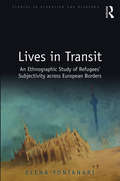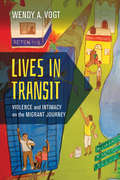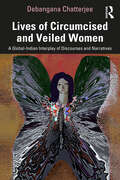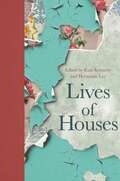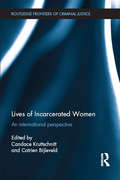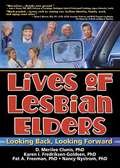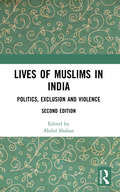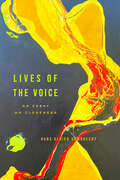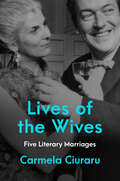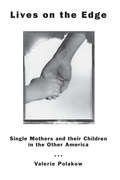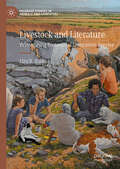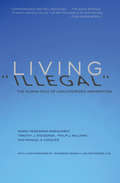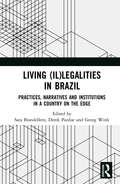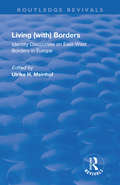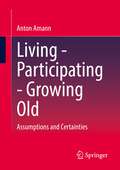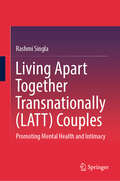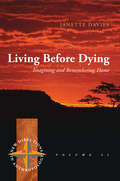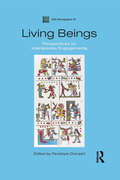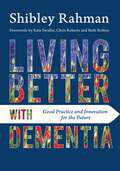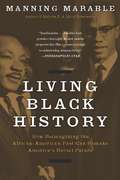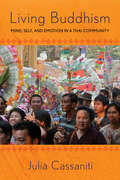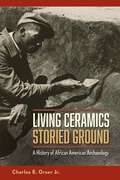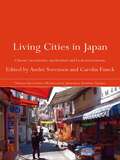- Table View
- List View
Lives in Transit: An Ethnographic Study of Refugees’ Subjectivity across European Borders (Studies in Migration and Diaspora)
by Elena FontanariThis book explores the border-crossing mobilities of refugees within Europe. Based on ethnographic fieldwork in Germany and Italy, it examines the precarious everyday lives of non-citizens living between and beyond EU internal borders. With attention to the constant re-construction of borders within Europe through negotiation practices, the author shows how the tensions that exist between refugees on the move and the structural constraints that limit their movement produce ‘interstices’ – small spaces of possibility that open up as a result of refugees’ struggling within structural constraints. A comprehensive understanding of the long-term effects of EU borders upon refugees’ lives is then afforded through a particular focus on the post-arrival period. Examining the protracted precariousness and multi-directional hyper-mobility in Europe that emerges from the dynamics of the relation between structural mechanisms and the agency of individuals, Lives in Transit reveals how the border regime in Europe impacts mostly upon the temporal rather than the spatial dimensions of refugees’ lives, affecting their subjectivities and sense of self. This ‘dispossession’ of time is advocated as the main problem with the experience of refugees in Europe, causing them to claim a temporal justice, which seeks to gain back control of their own lives and personhood. Calling for migration to be understood as a process of ‘becoming subjects’, this volume will appeal to scholars of sociology, anthropology, and politics with interests in migration and diaspora studies.
Lives in Transit: Violence and Intimacy on the Migrant Journey (California Series in Public Anthropology #42)
by Wendy A. VogtLives in Transit chronicles the dangerous journeys of Central American migrants in transit through Mexico. Drawing on fieldwork in humanitarian aid shelters and other key sites, Wendy A. Vogt examines the multiple forms of violence that migrants experience as their bodies, labor, and lives become implicated in global and local economies that profit from their mobility as racialized and gendered others. She also reveals new forms of intimacy, solidarity, and activism that have emerged along transit routes over the past decade. Through the stories of migrants, shelter workers, and local residents, Vogt encourages us to reimagine transit as a site of both violence and precarity as well as social struggle and resistance.
Lives of Circumcised and Veiled Women: A Global-Indian Interplay of Discourses and Narratives
by Debangana ChatterjeeThe book unravels the politics of representation and the process of exoticising women’s bodies through the prism of external gaze and knowledge production. It brings out the intricacies of representational discourses around cultural practices of female circumcision (FC)/female genital cutting (FGC) and Islamic veiling. Focusing on crucial international legal texts and national legislation, the book gives an overview of the cultural nuances in FC/FGC and juxtaposes it with the Indian variation, khafz. The author studies the international veiling narratives that conjure up a fractured discourse containing aspects of colonialism, Islamophobia, and Islamic fashion and maps them with the regional variations of Islamic purdah in India. The volume explores the cultural practice of khafz and purdah through narratives in India, portraying how representational factors from international discourses reflect on the Indian context and vice versa. Amid the world of binaries and polarised opinions, the book offers a nuanced analysis of the space in-between, characterised by narratives from women. By situating women’s narratives in relation to family, community, state, and international politics, the book explores the global-Indian interplay of discourses on FC/FGC and Islamic veiling. This volume will be of interest to scholars, students, and readers of gender studies, feminism, cultural and religious studies, sociology, South Asian studies, and International Relations.
Lives of Houses
by Hermione Lee Kate KennedyA group of notable writers—including UK poet laureate Simon Armitage, Julian Barnes, Margaret MacMillan, and Jenny Uglow—celebrate our fascination with the houses of famous literary figures, artists, composers, and politicians of the pastWhat can a house tell us about the person who lives there? Do we shape the buildings we live in, or are we formed by the places we call home? And why are we especially fascinated by the houses of the famous and often long-dead? In Lives of Houses, a group of notable biographers, historians, critics, and poets explores these questions and more through fascinating essays on the houses of great writers, artists, composers, and politicians of the past.Editors Kate Kennedy and Hermione Lee are joined by wide-ranging contributors, including Simon Armitage, Julian Barnes, David Cannadine, Roy Foster, Alexandra Harris, Daisy Hay, Margaret MacMillan, Alexander Masters, and Jenny Uglow. We encounter W. H. Auden, living in joyful squalor in New York's St. Mark's Place, and W. B. Yeats in his flood-prone tower in the windswept West of Ireland. We meet Benjamin Disraeli, struggling to keep up appearances, and track the lost houses of Virginia Woolf and Elizabeth Bowen. We visit Benjamin Britten in Aldeburgh, England, and Jean Sibelius at Ainola, Finland. But Lives of Houses also considers those who are unhoused, unwilling or unable to establish a home—from the bewildered poet John Clare wandering the byways of England to the exiled Zimbabwean writer Dambudzo Marechera living on the streets of London.With more than forty illustrations, Lives of Houses illuminates what houses mean to us and how we use them to connect to and think about the past. The result is a fresh and engaging look at house and home.Featuring Alexandra Harris on moving house ● Susan Walker on Morocco's ancient Roman House of Venus ● Hermione Lee on biographical quests for writers’ houses ● Margaret Macmillan on her mother's Toronto house ● a poem by Maura Dooley, "Visiting Orchard House, Concord, Massachusetts"—the house in which Louisa May Alcott wrote and set her novel Little Women ● Felicity James on William and Dorothy Wordsworth's Dove Cottage ● Robert Douglas-Fairhurst at home with Tennyson ● David Cannadine on Winston Churchill's dream house, Chartwell ● Jenny Uglow on Edward Lear at San Remo's Villa Emily ● Lucy Walker on Benjamin Britten at Aldeburgh, England ● Seamus Perry on W. H. Auden at 77 St. Mark's Place, New York City ● Rebecca Bullard on Samuel Johnson's houses ● a poem by Simon Armitage, "The Manor" ● Daisy Hay at home with the Disraelis ● Laura Marcus on H. G. Wells at Uppark ● Alexander Masters on the fear of houses ● Elleke Boehmer on sites associated with Zimbabwean writer Dambudzo Marechera ● Kate Kennedy on the mental asylums where World War I poet Ivor Gurney spent the last years of his life ● a poem by Bernard O'Donoghue, "Safe Houses" ● Roy Foster on W. B. Yeats and Thoor Ballylee ● Sandra Mayer on W. H. Auden's Austrian home ● Gillian Darley on John Soane and the autobiography of houses ● Julian Barnes on Sibelius and Ainola
Lives of Incarcerated Women: An international perspective (Routledge Frontiers of Criminal Justice)
by Candace Kruttschnitt Catrien BijleveldDrawing on qualitative and quantitative research from around the world, this book brings together renowned international scholars to explore life-course perspectives on women’s imprisonment. Instead of covering only one aspect of women’s carceral experiences, this book offers a broader perspective that encompasses women’s pathways to prison, their prison experiences and the effects of these experiences on their children’s well-being, as well as their subsequent chances of desisting from crime.Encompassing perspectives from the Netherlands, Belgium, Denmark, Scotland, the United States, Ukraine and Sri Lanka, this book uncovers the similarities across time and space in women offenders’ life histories and those of their children and examines the differences in women’s experiences and trajectories by shedding light on the moderating effects of particular cultural contexts. Lives of Incarcerated Women will be of interest to academics and students engaged in the study of punishment, penology, life-course criminology, women and crime and gender studies. It will also be of great interest to practitioners.
Lives of Lesbian Elders: Looking Back, Looking Forward
by D. Merilee Clunis J Dianne Garner Pat A. Freeman Nancy M. Nystrom Karen I. Fredriksen-GoldsenThe untold history of lesbian life from those who have lived it! Lives of Lesbian Elders: Looking Back, Looking Forward illuminates the hopes, fears, issues, and concerns of gay women as they grow older. Based on interviews with 62 lesbians ranging in age from 55 to 95, this very special book provides a historical account of the shared experiences of the lesbian community that is so often invisible or ignored in contemporary society. The book gives voice to their thoughts and feelings on a wide range of issues, including coming out, identity and the meaning of life, the role of family and personal relationships, work and retirement, adversity, and individual sources of strength and resilience. Cast off and overlooked at best or victims of scorn and prejudice at worst, lesbians in the twentieth century lived dual lives, their full voices unheard-until now. Lives of Lesbian Elders chronicles the life choices they made and their reasons for making them, set against the contexts of culture, politics, and the social mores of the eras in which they lived. Their stories of courage, resilience, resourcefulness, pride, and independence help restore lesbian history that has been forgotten, distorted, or disregarded and provide the information necessary to meet the future needs of aging lesbians. Lives of Lesbian Elders gives aging lesbians a chance to discuss their thoughts on a variety of topics, including: Coming out "You didn&’t talk about it . . . Until two years ago, I never even referred to a lesbian or would I allow the word to pass my lips" "I used to sneak into libraries and read about homosexuality and back in that era, it was not classy . . . it was classified as a disorder of some type" Identity "The only difference between me and anybody else is that I just happen to be sleeping with a woman" "I think I grew up not really knowing who I was and, I think, probably fighting all my life trying to find out who I was" Family "I feel very connected with the lesbian community here . . . I guess I would call that family" "Many years ago, my sister said: &’I think when they&’re ready, you need to explain to (the nieces) what a lesbian is, because I want them to hear the correct story . . . I want them to hear what it really is and not all these stupid rumors that go around&’" Work "I was going to become a youth minister at one point and it dawned on me in high school that there was no way the church was going to let me work with kids" "I didn&’t really finish my career . . . I still have dreams about the military and about not finishing . . . It was my choice, but it wasn&’t really my choice" Aging and the Future "I think financing, of course, is a real big problem for lesbian women" "I have a concern that if anything should happen to my partner-in growing older-of being isolated from the gay community" . . . and much more! Lives of Lesbian Elders: Looking Back, Looking Forward also includes appendices that present demographic data on the women who were interviewed for the book, information on historical timelines, and suggested readings on lesbian history. The book is an invaluable addition to the growing collective history of lesbians in the United States.
Lives of Muslims in India: Politics, Exclusion and Violence
by Abdul ShabanThe fast-consolidating identities along religious and ethnic lines in recent years have considerably ‘minoritised’ Muslims in India. The wide-ranging essays in this volume focus on the intensified exclusionary practices against Indian Muslims, highlighting how, amidst a politics of violence, confusing policy frameworks on caste and class lines, and institutionalised riot systems, the community has also suffered from the lack of leadership from within. At the same time, Indian Muslims have emerged as a ‘mass’ around which the politics of ‘vote bank’, ‘appeasement’, ‘foreigners’, ‘Pakistanis within the country’, and so on are innovated and played upon, making them further apprehensive about asserting their legitimate right to development. The important issues of the double marginalisation of Muslim women and attempts to reform the Muslim Personal Law by some civil society groups is also discussed. Contributed by academics, activists and journalists, the articles discuss issues of integration, exclusion and violence, and attempt to understand categories such as ‘identity’, ‘minority’, ‘multiculturalism’ and ‘nationalism’ with regard to and in the context of Indian Muslims. This second edition, with a new introduction, will be of great interest to scholars and researchers in sociology, politics, history, cultural studies, minority studies, Islamic studies, policy studies and development studies, as well as policymakers, civil society activists and those in media and journalism.
Lives of the Voice: An Essay on Closeness
by Hans Ulrich GumbrechtWhen it comes to understanding the ontology of individual existence—that is, the everyday behaviors that we all perform and hardly ever think about—the voice has a particularly complicated status. Together with writing, voice is the medium expressing ideas that, broadly speaking, we have previously formed in our minds. At the same time, voices trigger vague images and associations that do not have determinate forms. Writing in both a personal and philosophical register, Hans Ulrich Gumbrecht explores the complexity of the voice as an understudied philosophical, social, and existential phenomenon. He starts out with a focus on its core intellectual problem as "the knot of the voice" —referring to the inseparable proximity between meanings, images, and the physical perceptions on which they depend. In conversation with Nietzsche, Husserl, Heidegger, Derrida, Lyotard, Luhmann, and above all Roland Barthes, Gumbrecht addresses topics that range from the social functions of the voice to its status in different historical contexts, and to the ways in which the perception of voices animates imagination. Throughout, incisive analyses of moments such as Julius Caesar's purportedly high-pitched voice, the surprisingly fragile authority of God's voice in the Torah and in the Gospel, and Gumbrecht's own personal attachment to the voices of popular singers such as Edith Piaf, Elvis Presley, and Adele, create a portrait of the voice that is both philosophically challenging and entertaining to read.
Lives of the Wives: Five Literary Marriages
by Carmela Ciuraru"The five marriages that Carmela Ciuraru explores in Lives of the Wives provide such delightfully gossipy pleasure that we have to remind ourselves that these were real people whose often stormy relationships must surely have been less fun to experience than they are for us to read about."—Francine Prose, author of The VixenA witty, provocative look inside the tumultuous marriages of five writers, illuminating the creative process as well as the role of money, power, and fame in these complex and fascinating relationships."With an ego the size of a small nation, the literary lion is powerful on the page, but a helpless kitten in daily life—dependent on his wife to fold an umbrella, answer the phone, or lick a stamp."The history of wives is largely one of silence, resilience, and forbearance. Toss in celebrity, male privilege, ruthless ambition, narcissism, misogyny, infidelity, alcoholism, and a mood disorder or two, and it's easy to understand why the marriages of so many famous writers have been stormy, short-lived, and mutually destructive. "It's been my experience," as the critic and novelist Elizabeth Hardwick once wrote, "that nobody holds a man's brutality to his wife against him." Literary wives are a unique breed, requiring a particular kind of fortitude.Author Carmela Ciuraru shares the stories of five literary marriages, exposing the misery behind closed doors. The legendary British theatre critic Kenneth Tynan encouraged his American wife, Elaine Dundy, to write, then watched in a jealous rage as she became a bestselling author and critical success. In the early years of their marriage, Roald Dahl enjoyed basking in the glow of his glamorous movie star wife, Patricia Neal, until he detested her for being the breadwinner, and being more famous than he was. Elizabeth Jane Howard had to divorce Kingsley Amis to escape his suffocating needs and devote herself to her own writing. ("I really couldn't write very much when I was married to him," she once recalled, "because I had a very large household to keep up and Kingsley wasn't one to boil an egg, if you know what I mean.") Surprisingly, the most traditional partnership in Lives of the Wives is a lesbian couple, Una Troubridge and Radclyffe Hall, both of whom were socially and politically conservative and unapologetic snobs.As this erudite and entertaining work shows, each marriage is a unique story, filled with struggles and triumphs and the negotiation of power. The Italian novelists Elsa Morante and Alberto Moravia were never sexually compatible, and it was Morante who often behaved abusively toward her cool, detached husband, even as he unwaveringly admired his wife's talents and championed her work. Theirs was an unhappy union, yet it fueled them creatively and enabled both to become two of Italy's most important postwar writers.These are stories of vulnerability, loneliness, infidelity, envy, sorrow, abandonment, heartbreak, and forgiveness. Above all, Lives of the Wives honors the women who have played the role of muses, agents, editors, proofreaders, housekeepers, gatekeepers, amaneunses, confidantes, and cheerleaders to literary trailblazers throughout history. In revisiting the lives of famous writers, it is time in our #MeToo era to highlight the achievements of their wives—and the price these women paid for recognition and freedom. Lives of the Wives is an insightful, humorous, and poignant exploration of the intersection of life and art and creativity and love.
Lives on the Edge: Single Mothers and Their Children in the Other America
by Valerie PolakowOne out of five children, and one out of two single mothers, lives in destitution in America today. The feminization and "infantilization" of poverty have made the United States one of the most dangerous democracies for poor mothers and their children to inhabit. Why then, Valerie Polakow asks, is poverty seen as a private issue, and how can public policy fail to take responsibility for the consequences of our politics of distribution? Written by a committed child advocate, Lives on the Edge draws on social, historical, feminist, and public policy perspectives to develop an informed, wide-ranging critique of American educational and social policy. Stark, penetrating, and unflinching in its first-hand portraits of single mothers in America today, this work challenges basic myths about justice and democracy.
Livestock and Literature: Reimagining Postanimal Companion Species (Palgrave Studies in Animals and Literature)
by Liza B. BauerThis book explores the past and current traces that cows, pigs, chickens, and other animals used by humans have left in Anglophone literary fiction. In times of accelerated global warming, an acute pandemic, and breakthroughs in bioengineering practices, discussions on how to rethink the relationships to these animals have become as heated as perhaps never before. Livestock and Literature examines what literature has to contribute to these debates. In particular, it draws on counter-narratives to so-called livestock animals’ commodification in selected science- and speculative fiction (SF) works from the twenty-first century. These texts imagine ‘what if’ scenarios where “livestock” practice resistance, transform into biotechnologically modified, postanimal beings, or live in close companionship to humans. Via these three points of access, the study delineates the formal and thematic strategies SF authors apply to challenge anthropocentric and speciesist thought patterns. The aim is to shed light on how these alternative storyworlds expand readers’ understanding of the lives of farmed animals; seeking insight into how literature shapes human-animal relationships beyond the page.
Living "Illegal": The Human Face of Unauthorized Immigration
by Manuel A. Vasquez Timothy J Steigenga Marie Friedmann Marquardt Philip J. WilliamsLiving "Illegal" is an ambitious new account of the least understood and most relevant aspects of the American immigrant experience today. Based on years of research into the lives of ordinary migrants, oral histories, and individual testimonies, the book offers richly textured stories of real people-working, building families, and enriching their communities even as the political climate grows more hostile.Moving far beyond stock images and conventional explanations, Living "Illegal" challenges our assumptions about why immigrants come to the United States, where they settle, and how they have adapted to the often confusing patchwork of local immigration ordinances. This revealing narrative takes us into Southern churches (which have quietly emerged as the only organizations open to migrants), into the fields of Florida, onto the streets of major American cities during the historic immigrant rights marches of 2006, and back and forth across different national boundaries-from Brazil to Mexico and Guatemala.
Living "Illegal": The Human Face of Unauthorized Immigration
by Timothy J. Steigenga Marie Friedmann Marquardt Philip J. Williams Manuel A. VásquezA myth-busting account of the tragedies, trials, and successes of undocumented immigration in the United States. For decades now, America&’s polarizing debate over immigration revolved around a set of one-dimensional characters and unchallenged stereotypes. The resulting policies—from the creation of ICE in 2003 to Arizona&’s draconian law SB 1070—are dangerous and profoundly counterproductive. Based on years of research into the lives of ordinary migrants, Living &“Illegal&” offers richly textured stories of real people—working, building families, and enriching their communities even as the political climate grows more hostile. In the words of Publishers Weekly, it is a &“compassionate and well-reasoned exploration of why migrants come to the U.S. and how they integrate into American society.&” Moving beyond conventional arguments, Living &“Illegal&” challenges our assumptions about who these people are and how they have adapted to the confusing patchwork of local immigration ordinances. This revealing narrative takes us into Southern churches (often the only organizations open to migrants), into the fields of Florida, onto the streets of major American cities during the immigrant rights marches of 2006, and across national boundaries—from Brazil to Mexico and Guatemala.
Living (Il)legalities in Brazil: Practices, Narratives and Institutions in a Country on the Edge
by Derek Brandellero Sara Pardue Georg WinkReflecting on some of Brazil’s foremost challenges, this book considers the porous relationship between legality and illegality in a country that presages political and societal changes in hitherto unprecedented dimensions. It brings together work by established scholars from Brazil, Europe and the United States to think through how (il)legalities are produced and represented at the level of institutions, (daily) practice and culture. Through a transdisciplinary approach, the chapters cover issues including informal work practices (e.g. street vendors), urban squatter movements and migration. Alongside social practices, the volume features close analyses of cultural practices and cultural production, including migrant literature, punk music and indigenous art. The question of (il)legalities resonates beyond Brazil’s borders, as concepts such as "lawfare" have crept into vocabularies, and countries the world over grapple with issues like state interference, fake news and the definition of "illegal" migration. This is valuable reading for scholars in Brazilian and Latin American Studies, as well as those working in literary and cultural studies, anthropology, sociology, geography and political science.
Living (with) Borders (with) Borders (with) Borders (with) Borders (with) Borders (with) Borders (with) Borders (with) Borders: Identity Discourses on East-West Borders in Europe: Identity Discourses on East-West Borders in Europe
by Ulrike H. MeinhofThis title was first published in 2002. Most nation states in Europe have undergone dramatic social and political upheaval with the construction of new or the redefinition of existing national borders. This book uses discourse analytical methods to focus on and unravel the complex cultural identities of people living in communities that straddle the border stretching from the Adriatic to the Baltic Sea.
Living - Participating - Growing Old: Assumptions and Certainties
by Anton AmannLife must be understood as the result of evolution, and human life as the emergence of the species Sapiens from the genus Homo of the family of apes. If the emergence of human life as an evolutionary fact is coupled with the notion of social life, we are referred to the constructive production of human life forms, of which social participation is an integral part. On the one hand, participation is tied back to the phylogenesis of the species Sapiens, but on the other hand, it has to be newly acquired and practiced by every human being in the process of ontogenesis, depending on the environment. Participation in old age is a separate specification of the conditions of this process and can be illustrated on the basis of a large number of empirical findings.
Living Apart Together Transnationally (LATT) Couples: Promoting Mental Health and Intimacy
by Rashmi SinglaThis book provides deep insight into intimacy and distance in the complex, globalised world through the newly coined concept of couples living apart together transnationally (LATT). Based on a review of the past four decades’ seminal studies and narratives from a qualitative empirical study, including both heterosexual and same-sex couples, it shows intimacy can be maintained without geographical proximity. The book has a rich, layered, and nuanced exploration of LATT couples' experiences of relationship maintenance across distance and time through diverse ways, such as digital emotions, online sexual activity, and meaning–making through spirituality, which challenge existing Eurocentric conceptualisations of intimacy and relationships. It also reveals an array of “good practices” for relationship maintenance across countries, which can inspire other couples and practitioners. Thus, the book is an important resource, not only for academics in the disciplines of psychology, anthropology, cultural studies, family science, sociology, migration, and communication but particularly useful for practitioners dealing with couple relationships, such as counselors, social workers, and mental health advisors. It is also relevant for international organizations and multinational corporations working with couples living apart together transnationally.“The implications of this book for ‘how we live now’ are clear – in a more closely connected and mobile world, the possibility of living our most intimate relationships across distance will affect increasing numbers of us… the book’s informative, theoretical, and practical messages have valuable lessons for many of us now and in the future.”Dr Lucy Williams,University of Kent, the UK· “Living Apart Together Transnationally (LATT) Couples: Promoting mental health and intimacy” gives us insights into the everyday lives of couples living apart together (LAT) in a contemporary world characterized by globalisation, and pandemics that have affected border controls and migration policies in different countries. Rashmi Singla invites us to challenge the way we understand intimate relationships that are connected to physical proximity and provides us with innovative ways to maintain emotional and physical intimacy despite geographical separation. Sayaka Osanami TörngrenAssociate Professor of International Migration and Ethnic Relations, Malmö University, SwedenDr. Rashmi Singla’s book “Living Apart Together Transnationally” addresses a very important problem many modern couples encounter living apart in different countries. The increasing globalization of the job market and mass migration in the past four decades have made this topic more important than ever before. However, research about love and life in such conditions is still limited. The research presented in this book reveals some new qualitative research findings about how partners maintain health and intimacy in such challenging conditions. This book presents novel and invaluable research for scholars in the area of love and couple relationships. Victor Karandashev, Ph. D.,Professor of Aquinas College, Michigan, The U.S.A.Dr. Rashmi Singla's work, 'Living Apart Together Transnationally (LATT),' stands as a profoundly empirical exploration of long-distance couples spanning international borders. The book provides captivating revelations into the lives, intimacies, and spiritual dimensions of such relationships. Offering an interdisciplinary approach, it establishes a robust groundwork for further investigations in this emerging field. Lise Paulsen Galal, PhD, Associate Professor in Intercultural Studies, Roskilde University, Denmark.How important is proximity in intimate relationships when partners live apart in different countries? This question sits at the core of this timely book, which offers new insights, in part
Living Before Dying: Imagining and Remembering Home (New Directions in Anthropology #41)
by Janette DaviesThis in-depth description of life in a nursing/care home for 70 residents and 40 staff highlights the daily care of frail or ill residents between 80 and 100 years of age, including people suffering with dementia. How residents interact with care assistants is emphasised, as are the different behaviours of men and women observed during a year of daily conversations between the author, patients and staff, who share their stories of the pressures of the work. Living Before Dying shows a world where, in extreme old age, people have to learn how to cope with living communally.
Living Beings: Perspectives on Interspecies Engagements (ASA Monographs)
by Penelope DransartLiving Beings examines the vital characteristics of social interactions between living beings, including humans, other animals and trees.Many discussions of such relationships highlight the exceptional qualities of the human members of the category, insisting for instance on their religious beliefs or creativity. In contrast, the international case studies in this volume dissect views based on hierarchical oppositions between human and other living beings. Although human practices may sometimes appear to exist in a realm beyond nature, they are nevertheless subject to the pull of natural forces. These forces may be brought into prominence through a consideration of the interactions between human beings and other inhabitants of the natural world.The interplay in this book between social anthropologists, philosophers and artists cuts across species divisions to examine the experiential dimensions of interspecies engagements. In ethnographically and/or historically contextualized chapters, contributors examine the juxtaposition of human and other living beings in the light of themes such as wildlife safaris, violence, difference, mimicry, simulation, spiritual renewal, dress and language.
Living Better with Dementia: Good Practice and Innovation for the Future
by Chris Roberts Beth Britton Kate Swaffer Shibley RahmanWhat do national dementia strategies, constantly evolving policy and ongoing funding difficulties mean for people living well with dementia? Adopting a broad and inclusive approach, Shibley Rahman presents a thorough critical analysis of existing dementia policy, and tackles head-on current and controversial topics at the forefront of public and political debate, such as diagnosis in primary care, access to services for marginalised groups, stigma and discrimination, integrated care, personal health budgets, personalised medicine and the use of GPS tracking. Drawing on a wealth of diverse research, and including voices from all reaches of the globe, he identifies current policy challenges for living well with dementia, and highlights pockets of innovation and good practice to inform practical solutions for living better with dementia in the future. A unique and cohesive account of where dementia care practice and policy needs to head, and why, and how this can be achieved, this is crucial reading for dementia care professionals, service commissioners, public health officials and policy makers, as well as academics and students in these fields.
Living Black History: How Reimagining the African-American Past Can Remake America's Racial Future
by Manning MarableAre the stars of the Civil Rights firmament yesterday's news? In Living Black History scholar and activist Manning Marable offers a resounding "No!" with a fresh and personal look at the enduring legacy of such well-known figures as Malcolm X, Martin Luther King, Jr., Medgar Evers and W.E.B. Du Bois. Marable creates a "living history" that brings the past alive for a generation he sees as having historical amnesia. His activist passion and scholarly memory bring immediacy to the tribulations and triumphs of yesterday and reveal that history is something that happens everyday. Living Black History dismisses the detachment of the codified version of American history that we all grew up with. Marable's holistic understanding of history counts the story of the slave as much as that of the master; he highlights the flesh-and-blood courage of those figures who have been robbed of their visceral humanity as members of the historical cannon. As people comprehend this dynamic portrayal of history they will begin to understand that each day we-the average citizen-are "makers" of our own American history. Living Black History will empower readers with knowledge of their collective past and a greater understanding of their part in forming our future.
Living Buddhism: Mind, Self, and Emotion in a Thai Community
by Julia CassanitiIn Living Buddhism, Julia Cassaniti explores Buddhist ideas of impermanence, nonattachment, and intention as they are translated into everyday practice in contemporary Thailand. Although most lay people find these philosophical concepts difficult to grasp, Cassaniti shows that people do in fact make an effort to comprehend them and integrate them as guides for their everyday lives. In doing so, she makes a convincing case that complex philosophical concepts are not the sole property of religious specialists and that ordinary lay Buddhists find in them a means for dealing with life's difficulties. More broadly, the book speaks to the ways that culturally informed ideas are part of the psychological processes that we all use to make sense of the world around us. In an approachable first-person narrative style that combines interview and participant-observation material gathered over the course of two years in the community, Cassaniti shows how Buddhist ideas are understood, interrelated, and reinforced through secular and religious practices in everyday life. She compares the emotional experiences of Buddhist villagers with religious and cultural practices in a nearby Christian village. Living Buddhism highlights the importance of change, calmness (as captured in the Thai phrase jai yen, or a cool heart), and karma; Cassaniti's narrative untangles the Thai villagers' feelings and problems and the solutions they seek.
Living Cargo: How Black Britain Performs Its Past
by Steven BlevinsOffering a wide-ranging study of contemporary literature, film, visual art, and performance by writers and artists who live and work in the United Kingdom but also maintain strong ties to postcolonial Africa and the Caribbean, Living Cargo explores how contemporary black British culture makers have engaged with the institutional archives of colonialism and the Atlantic slave trade in order to reimagine blackness in British history and to make claims for social and political redress. Steven Blevins calls this reimagining &“unhousing history&”—an aesthetic and political practice that animates and improvises on the institutional archive, repurposing it toward different ends and new possibilities. He discusses the work of novelists, including Caryl Phillips, Fred D&’Aguiar, David Dabydeen, and Bernardine Evaristo; filmmakers Isaac Julien and Inge Blackman; performance poet Dorothea Smartt; fashion designer Ozwald Boateng; artists Hew Locke and Yinka Shonibare; and the urban redevelopment of Bristol, England, which unfolded alongside the public demand to remember the city&’s slave-trading past. Living Cargo argues that the colonial archive is neither static nor residual but emergent. By reassembling historical fragments and traces consolidated in the archive, these artists not only perform a kind of counter-historiography, they also imagine future worlds that might offer amends for the atrocities of the past.
Living Ceramics, Storied Ground: A History of African American Archaeology
by Charles E. Orser Jr.The role of historical archaeology in the study of African diaspora history and culture Exploring the archaeological study of enslavement and emancipation in the United States, this book discusses significant findings, the attitudes and approaches of past researchers, and the development of the field. Living Ceramics, Storied Ground highlights the ways historical archaeology can contribute to the study of African diaspora history and culture, as much of the daily life of enslaved people was not captured through written records but is evidenced in the materials and objects left behind. Including debates about cultural survivals in the 1920s, efforts to find “Africanisms” at Kingsley plantation in the 1960s, and the realization—as late as the 1970s—that colonoware pottery was created by enslaved people, Charles Orser looks at the influential and often mistaken ideas of prominent anthropologists, archaeologists, and historians. Extending to the present, Orser describes how archaeology better recognizes and appreciates the variety and richness of African American culture during slavery, due in large part to the Black archaeologists, past and present, who have worked to counter racism in the field. While acknowledging the colonial legacy of archaeology, Charles Orser outlines the ways the discipline has benefitted by adopting antiracist principles and partnerships with descendant communities. This book points to the contributions of excavators and researchers whose roles have been overlooked and anticipates exciting future work in African American archaeology. Publication of this work made possible by a Sustaining the Humanities through the American Rescue Plan grant from the National Endowment for the Humanities.
Living Cities in Japan: Citizens' Movements, Machizukuri and Local Environments (Nissan Institute/Routledge Japanese Studies)
by Carolin Funck André SorensenOver the last fifteen years local citizens' movements have spread rapidly throughout Japan. Created with the aim of improving the quality of the local environment, and of environmental management processes, such activities are widely referred to as machizukuri, and represent an important development in local politics and urban management in Japan. This volume examines the growth and nature of such civil society participation in local urban and environmental governance, raising important questions about the changing roles of and relations between central and local government, and between citizens and the state, in managing shared spaces. The machizukuri processes studied here can be seen as the focus of an important emerging trend toward increased civic participation in managing processes of urban change in Japan. The contributors provide a comprehensive overview of the machizukuri phenomenon through examination not only of theory and history, but also of case studies illustrating real changes in the institutions of place making and neighbourhood governance. Living Cities in Japan will be of particular value to readers interested in social, urban, geographical and environmental studies.
